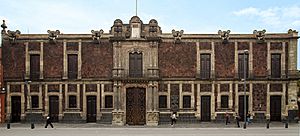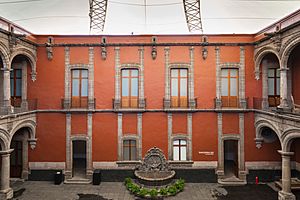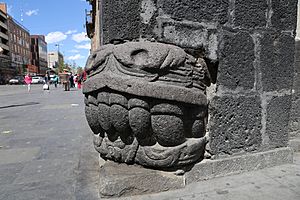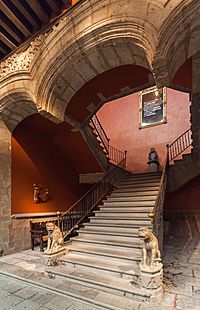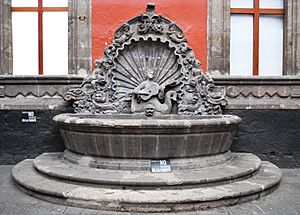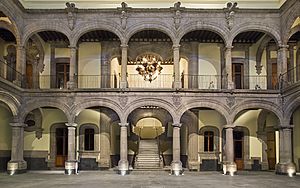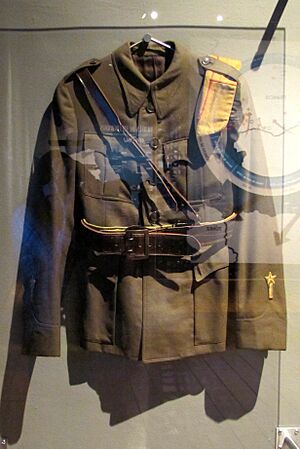Museum of Mexico City facts for kids
| Museo de la Ciudad de Mexico | |
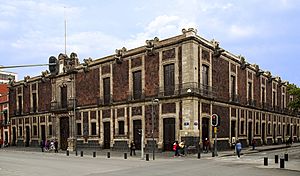
Façade of the palace
|
|
| Former name | House of the counts of Santiago de Calimaya |
|---|---|
| Established | 31 October 1964 |
| Location | Historic center of Mexico City, Mexico City |
| Type | History museum |
| Architect | Francisco Guerrero y Torres |
| Owner | Mexico City government |
| Public transit access | Zócalo/Tenochtitlan metro station, Sistema de Transporte Colectivo |
The Museum of Mexico City (Spanish: Museo de la Ciudad de Mexico) is a fascinating place in the heart of Mexico City. It's located on Pino Suarez street, not far from the famous Zocalo square. This grand building used to be a palace. It belonged to the Counts of Santiago de Calimaya, who were descendants of one of the Spanish conquerors, Hernán Cortés.
The palace was greatly changed over time to look mostly as it does today. The family lived there until 1960. Then, the Mexico City government bought it. They turned it into the museum you can visit now. The museum shows off parts of the old palace. It also has 26 rooms that tell the story of Mexico City. This story goes all the way from Aztec times to the present day. Inside, you'll also find a library and the art studios of painter Joaquín Clausell. He lived in this very building in the late 1800s and early 1900s. The palace itself was finished in 1779. The architect who completed it was Francisco Antonio de Guerrero y Torres.
Contents
History of the Palace: From Home to Museum
The story of this old palace began in 1527. That's when Mr. Juan Gutiérrez Altamirano arrived in New Spain (which is now Mexico). He came from Cuba to work for Hernán Cortés. Cortés gave land near the Templo Mayor to his friends and helpers. Juan Gutiérrez Altamirano received the land where the palace now stands. He had recently married Juana Altamirano Pizarro, who was Cortés's cousin.
The first house built here was like a "fortress-house." It was designed to be strong and defend against problems. This early building looked like a three-story tower. It had a door on the ground floor and many windows. It even had a pointy roof and a tower on one side.
Becoming Counts of Santiago de Calimaya
It took three generations for the family to get a noble title. They became the "Counts of Santiago de Calimaya." They were called "Santiago" because they honored Saint James the Great, a Spanish patron saint. "Calimaya" was the name of a town given to them. This town brought them a lot of wealth.
The title of count was given to Don Fernando Altamirano y Velasco in 1616. He was a direct descendant of Juan Gutiérrez Altamirano. This title was used by fourteen generations of the family.
Rebuilding the Grand Palace
The Altamirano Velasco family became very successful. The old family home needed a lot of work. Earthquakes and floods had damaged it badly. So, the seventh count decided to completely rebuild it. The old building was torn down to make way for a new, grander palace.
This new construction happened around the time of the Bourbon reforms. These changes meant the Spanish Crown took over many properties. The counts faced money problems, but their noble status helped them. They got permission to tax their lands. This money helped them pay for the palace's rebuilding.
The palace was rebuilt between 1776 and 1779. The builder was Francisco Antonio de Guerrero y Torres. He also designed other important buildings. In colonial times, Pino Suárez street was a very fashionable place for noble families to live. Their homes were lined up with the Royal Palace.
The front of the palace was covered in red volcanic stone called tezontle. The main entrance and windows were made of gray-white stone called cantera. During these renovations, an amazing Aztec serpent's head was found. It was likely uncovered and then placed as a special cornerstone for the building. The cost to remodel the house was very high.
A chapel was also added to the palace between 1778 and 1779. Back then, it was common for noble families to have their own chapels. This was because upper-class women often didn't go out to public churches. So, they had private religious services right in their homes.
The family lived in the house until 1964. This was unusual, as most noble families had left their grand homes much earlier. The government of Mexico City bought the palace from the Cervantes family. They then decided to turn it into the museum we see today.
What the Palace Looks Like
During the colonial period, this palace was one of the most impressive in New Spain. It covers a large area, about 2,762 square meters. It has strong stone foundations and thick walls. The outside is covered in tezontle stone. The main entrance and balcony are made of cantera stone. You can also see decorative carvings called friezes made of basalt.
The main entrance has a Baroque style. It features four clawed feet and decorative faces called mascarons. There are also gargoyles shaped like cannons. These could actually be fired, but only with special permission! The look of the building today comes from the changes made in the late 1700s. It was one of the last big Baroque projects in Mexico.
One of the most special parts of the building is the Aztec serpent's head. It was probably found during the renovations. People think it might have come from the Templo Mayor. It was then placed as a cornerstone for the original house.
Inside the Palace
The palace has two floors and two courtyards. This was common for noble homes in Mexico. The family's coat-of-arms decorates the arches in the main courtyard. A unique feature is the shell-shaped fountain in the main courtyard. It looks old and is very close to the windows. This suggests it was there before the big remodeling in the 1700s. The fountain has a statue of a Nereid (a sea nymph) playing a guitar. This sea theme might remind us of the Counts' sea travels, perhaps even to the Philippines.
The house used to have its own chapel. Today, only parts of its front remain. One room that is still almost exactly as it was is the music room. In the 1800s, music was a very important part of daily life for wealthy families. They would play music by famous European composers. They also enjoyed music by Mexican composers. Music rooms were important to show how cultured a family was.
The main staircase is in the main courtyard, across from the fountain. The dogs on the stair railing and the mascarons above the main door look a bit like art from Asia. This made some people think that the wood and workers might have come from the Philippines. However, both the wood and the craftsmanship are actually from Mexico.
The Museum of Mexico City Today
From the late 1800s to the mid-1900s, this part of Mexico City became less wealthy. The palace was divided into smaller apartments for rent. By the late 1950s, it had become a crowded living space. This happened even though it was declared a national monument in 1931.
In 1960, the Mexico City government bought the building. They decided to turn it into a museum. Architect Pedro Ramírez Vázquez was hired to remodel it. He changed the old rooms into exhibition halls. In 1964, the Museum of Mexico City opened. It focused on what Mexico City was like and what it hoped to become.
By 1992, the museum was not doing well. It closed, and there were ideas to turn it into a hotel. But that never happened. In 1997, the museum was reorganized and reopened. Now, it focuses on Mexico City's past, present, and future. It works with other important museums in Mexico.
Exhibits and Collections
The museum has 26 rooms that show how Mexico City has changed. It covers everything from Aztec times to today. The permanent collection is divided into different time periods:
- The pre-Hispanic period (before the Spanish arrived)
- The colonial period (1500s to 1700s)
- The 1800s
- The 1900s
The pre-Hispanic room has items like metates (stones for grinding corn), jars, bowls, and incense burners. It also displays Aztec codices (ancient books) and maps. These objects show what daily life was like for people in the Mexican highlands long ago. The rooms for the colonial era, 1800s, and 1900s also have everyday items. These include furniture, desks, vases, and art like sculptures and paintings.
The studio of painter Joaquín Clausell is on the upper floor. He lived there because he was married to Angela Cervantes, a descendant of the Counts. Clausell welcomed many famous visitors to his studios. The rooms contain 1,300 sketches by the artist. These include portraits, images of Christ, angels, animals, and mythological scenes. His work shows influences from the Impressionism and Symbolism art movements. Some of his works are just small figures he made to clean his brushes! Clausell's art is displayed here through an agreement with the Museo Nacional de Arte. The two museums share his works, rotating them every two months.
The Jaime Torres Bodet Library
The Jaime Torres Bodet Library inside the museum has about 10,000 books. Most of these books are about Mexico City. The collection includes old newspapers from the 1800s. It also has maps of the city and original copies of laws passed by the city council. It's a great place to learn about the city's history.
Other Activities and Events
The museum also hosts temporary exhibits. They have educational programs for both children and adults. There's a special room about the river system in the Valley of Mexico. You can also find a bookstore and take guided tours.
One recent event was "Beats & Bits." This exhibit explored the history of electronic music from the early 1900s to today. Another event was an exhibit on Mexican wrestling, known as lucha libre. It featured photographs, costumes, and other items related to this exciting sport.
In 1999, the mayor of Mexico City, Cuauhtémoc Cárdenas Solórzano, gave the keys of the city to Pope John Paul II right here at the museum.
Images for kids
See also
 In Spanish: Museo de la Ciudad de México para niños
In Spanish: Museo de la Ciudad de México para niños


